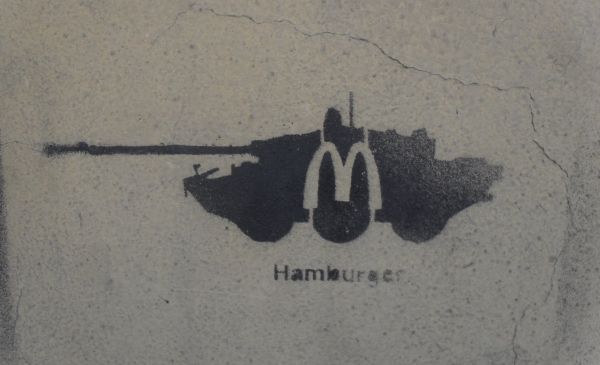
I think Howard Schultz blinked. It’s understandable — when McDonald’s runs ads that say, “four dollars is dumb,” it’s bound to piss him off. I’ll be watching for the ads to see how he’s responding.
BUT, I think he’s missing the real value in the Starbucks proposition: He pioneered the “third space” notion — gotta go to work; gotta go home; Starbucks is the “green room” for both venues.
First up: Anyone who has ordered a cup of coffee at a McDonald’s or Dunkin’ Donuts knows they don’t want you to linger there — and you don’t want to. Their model is the old one — turn those tables, move ’em in and out, fast.
Starbucks is the place you go and feel it’s perfectly okay to linger. That’s a tremendous value — particularly as people get laid off and need a place to go (rather than hanging out at home in their bathrobes) to work on their resume, see people, wait for the interview or decompress after it.
I think Starbucks ought to be talking about that welcoming part of the brand DNA, that and then too, there’s the less consumer-centric bits that still add up to a terrific brand personality, i.e. the professionalization of the barista — and the company’s values in terms of health care and stock options for part-time workers, free trade coffee, all that.
Starbucks shouldn’t be competing on price with McDonald’s.
The Blake Project Can Help: The Brand Positioning Workshop
Branding Strategy Insider is a service of The Blake Project: A strategic brand consultancy specializing in Brand Research, Brand Strategy, Brand Licensing and Brand Education





7 comments
Derrick Daye
May 2, 2009 at 12:38 am
Interesting viewpoint Kate.
The response needs to be strong and quick. McDonald’s is preparing to launch its full-scale assault on Starbucks next week when it rolls out coffee bars called McCafes at more than 11,000 restaurants nationwide.
Derrick
Jay Ehret
May 2, 2009 at 9:13 am
Starbucks new ads will debut in the NY Times tomorrow. They will say: “Beware of a Cheaper Cup of Coffee. It Comes With a Price.”
In the words of Austin Powers, Schultz has lost his mojo. Now he’s directly answering McDonald’s and Dunkin Donuts with an ad that has nothing to do with being in the third place. On top of that he’s using the New York Times. Ugh.
Derrick Daye
May 2, 2009 at 4:28 pm
Thanks Jay.
So how far has Starbucks strayed from their guiding principles? You be the judge:
https://brandingstrategyinsider.com/2007/06/engineering_the.html
Derrick
Charles
May 3, 2009 at 4:48 am
I was in a Starbucks last week and a customer asked for something and the barista said “we’re not supposed to, we’ll get yelled at”. This just reinforced for me that Starbucks has lost it’s mojo. They’re becoming more similar to McDonalds than different.
Eric Tsai
May 3, 2009 at 9:16 pm
I have seem more and more people conducting interviews and meetings these days at both Starbucks and McDonalds. In fact, where I work there is a food court with places to sit inside and out, so many people have meetings all around, plus you can get the same internet from ATT at both places now.
I think the perception of value is “shifting”, where Starbucks had its run for the 3rd space value but that doesn’t mean McDonalds can’t own the same space. Heck, they were the first to have kids playgrounds for parents to stay around!
Starbucks must bring more value because user experience CAN BE commoditized and duplicated.
Eric Tsai
Anna
May 4, 2009 at 8:05 pm
I am an ex-Starbucks drinker who recently abandoned my favorite brand for cheaper options. I saw their ad in the WSJ today and thought it sucked. So I even tried McD’s iced coffee today out of research purposes – it is horrid. Starbucks is desperately in need of radical measures and I’d build the rebranding campaign on sampling McD’s coffees – maybe even offer free money to go there and try it. There is no better testimony to superiority of Starbucks’ product.
miro
May 5, 2009 at 7:17 am
Invariably most strategies go out the door when same store sales or other comparables start to falter.
The question to ask is what is the core brand promise and how much of a price premium can that support in this current environment?
Nothing is ever set on an absolute foundation so when the ground shifts – one must adapt in some fashion.
Perhaps the lesson to be learned by all is that strategies must be set from the beginning that recognize this possibility/inevitability so as not to paint oneself too deeply in the corner.
Miro
Comments are closed.